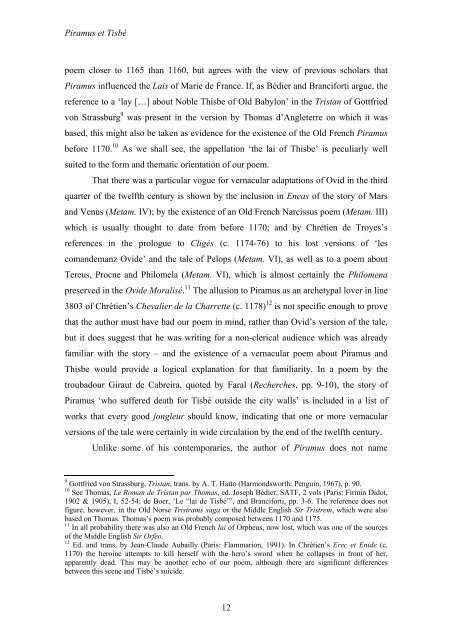You also want an ePaper? Increase the reach of your titles
YUMPU automatically turns print PDFs into web optimized ePapers that Google loves.
Piramus et Tisbé<br />
poem closer to 1165 than 1160, but agrees with the view of previous scholars that<br />
Piramus influenced the Lais of Marie de France. If, as Bédier and Branciforti argue, the<br />
reference to a ‘lay […] about Noble Thisbe of Old Babylon’ in the Tristan of Gottfried<br />
von Strassburg 9 was present in the version by Thomas d’Angleterre on which it was<br />
based, this might also be taken as evidence for the existence of the Old French Piramus<br />
before 1170. 10 As we shall see, the appellation ‘the lai of Thisbe’ is peculiarly well<br />
suited to the form and thematic orientation of our poem.<br />
That there was a particular vogue for vernacular adaptations of Ovid in the third<br />
quarter of the twelfth century is shown by the inclusion in Eneas of the story of Mars<br />
and Venus (Metam. IV); by the existence of an Old French Narcissus poem (Metam. III)<br />
which is usually thought to date from before 1170; and by Chrétien de Troyes’s<br />
references in the prologue to Cligés (c. 1174-76) to his lost versions of ‘les<br />
comandemanz Ovide’ and the tale of Pelops (Metam. VI), as well as to a poem about<br />
Tereus, Procne and Philomela (Metam. VI), which is almost certainly the Philomena<br />
preserved in the Ovide Moralisé. 11 The allusion to Piramus as an archetypal lover in line<br />
3803 of Chrétien’s Chevalier de la Charrette (c. 1178) 12 is not specific enough to prove<br />
that the author must have had our poem in mind, rather than Ovid’s version of the tale,<br />
but it does suggest that he was writing for a non-clerical audience which was already<br />
familiar with the story – and the existence of a vernacular poem about Piramus and<br />
Thisbe would provide a logical explanation for that familiarity. In a poem by the<br />
troubadour Giraut de Cabreira, quoted by Faral (Recherches, pp. 9-10), the story of<br />
Piramus ‘who suffered death for Tisbé outside the city walls’ is included in a list of<br />
works that every good jongleur should know, indicating that one or more vernacular<br />
versions of the tale were certainly in wide circulation by the end of the twelfth century.<br />
Unlike some of his contemporaries, the author of Piramus does not name<br />
9 Gottfried von Strassburg, Tristan, trans. by A. T. Hatto (Harmondsworth: Penguin, 1967), p. 90.<br />
10 See Thomas, Le Roman de Tristan par Thomas, ed. Joseph Bédier, SATF, 2 vols (Paris: Firmin Didot,<br />
1902 & 1905), I, 52-54; de Boer, ‘Le “lai de Tisbé”’, and Branciforti, pp. 3-6. The reference does not<br />
figure, however, in the Old Norse Tristrams saga or the Middle English Sir Tristrem, which were also<br />
based on Thomas. Thomas’s poem was probably composed between 1170 and 1175.<br />
11 In all probability there was also an Old French lai of Orpheus, now lost, which was one of the sources<br />
of the Middle English Sir Orfeo.<br />
12 Ed. and trans. by Jean-Claude Aubailly (Paris: Flammarion, 1991). In Chrétien’s Erec et Enide (c.<br />
1170) the heroine attempts to kill herself with the hero’s sword when he collapses in front of her,<br />
apparently dead. This may be another echo of our poem, although there are significant differences<br />
between this scene and Tisbé’s suicide.<br />
12
















